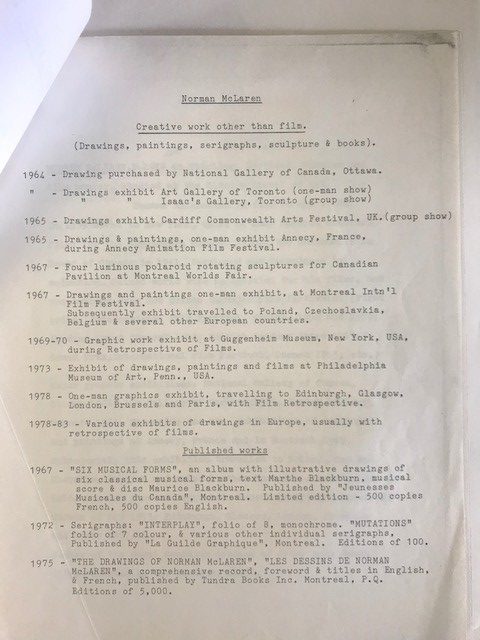Our Artist in Residence, Jennifer Wicks, shares some of her musings from her work in the Norman McLaren archive:
Over these past few weeks, I’ve been looking specifically at technical notes, press articles, interviews and letters written by McLaren to some of his family and closest friends that document his creative process. I mentioned in my last post just how thorough his technical notes are, but through these other sources it’s clear how eager he was to share his experiments widely with peers and critics, friends, and family. It’s fascinating not least because it also gives a sociological snapshot of the time; different journalistic styles (British post war vs Canadian for instance), and the long-lost art of letter writing.
One aspect of his work he discussed extensively was animated sound. In a National Film Board of Canada article in 1948 Norman McLaren wrote on animated sound that it, “opens up a new field of tonal and musical expression freed from the ordinary laws of acoustics, instruments and performers”. This break away from convention and conservative ideas, to disrupt and create new meaning, has and always will be important in understanding the human condition.


In some interviews I sense that McLaren tires of the conservative questions about his experimental approach to making work, specifically his experiments with ‘synthetic sound’. In 1952 he wrote a paper “A Brief Summary of the Early History of Animated Sound on Film”, in which he said:
“ So many people insist on calling it synthetic sound or synthetic music as if it were a substitute, but it isn’t. For the example, the animated movie isn’t a substitute for a live movie… If I do without a camera and create my own music track by drawing directly on the film, it isn’t because I despise musical instruments and recording equipment. It merely means that actual recorded music isn’t just what I want for that particular picture, and that animated sound is better for my purposes….”
Of course, he notes that he is not the first to experiment with drawn on sound: in the early 1930’s some Russian technicians and the German film maker Rudolf Pfenniger in his film ‘Tonende Hanschrift’ (‘Sound Handwriting’), 1931, made experiments along these lines, as did the Whitney Brothers in California.
In another paper McLaren writes:
“ It means a lot to me to have the freedom to experiment and to pick my own subjects, and to do them the way I want, but apart from that I like freedom from the usual equipment of film making. Physical things like scenery, and light, and cameras, and sound booms, and all that. The more things that get between a filmmaker and his picture, the less chance he has doing the films he has in mind. My own feeling is for a very direct personal approach. It goes right back to my very first contact with film…”
Although McLaren didn’t receive a diploma from GSA, “I neglected my art school classes and made movies instead. I failed my diploma but that in no way perturbed me”, he was fortunate to have the freedom to fully experiment through the security of a studio (National Film Board of Canada (NFB)), facilities and technicians at hand and this was instrumental in his success. It’s a dreamy contemplation to have the reassurance of a supportive environment, what artist has that long term? But also, this freedom to experiment and keep at a minimum technical mechanism was fundamental to McLaren’s process. He didn’t tie himself to the constraints of convention; he created tension between frames on the film, his drawings and between the percussive rhythms and distinctive drawn-on sounds through an intimate relationship he had with his material of choice. I think it’s still important today to have the experimental freedom, the disruption of convention, the repetitive and primitivist experiments that create chance outcomes that McLaren talks about, and lived by, and which I am very much drawn to. Making work does not necessarily mean rejecting such crude methods, but to oppose, or to question aesthetically, the slick immediacy of technology nowadays, in an attempt at further exploring memory and perception. It also illustrates the importance of time and space and freedom to explore your practice (and I’m very grateful for this residency in enabling this).

